Report on Developing Organizational Vision and Strategic Direction
VerifiedAdded on 2020/02/05
|12
|3198
|91
Report
AI Summary
This report provides a comprehensive analysis of developing organizational vision and strategic direction. It begins by exploring the role of stakeholders, factors influencing vision, and the process of vision development. The report then delves into strategic direction determination, including stakeholder analysis, competitor analysis, and needs/gap analysis. It further examines methods for communicating the vision within the organization and to external stakeholders. The report also discusses leadership behavior in promoting the vision and embedding it within the organization, concluding with a review of the strategic planning process. The report uses PESTLE analysis as a tool for examining the external environment and discusses both top-down approach for implementation.
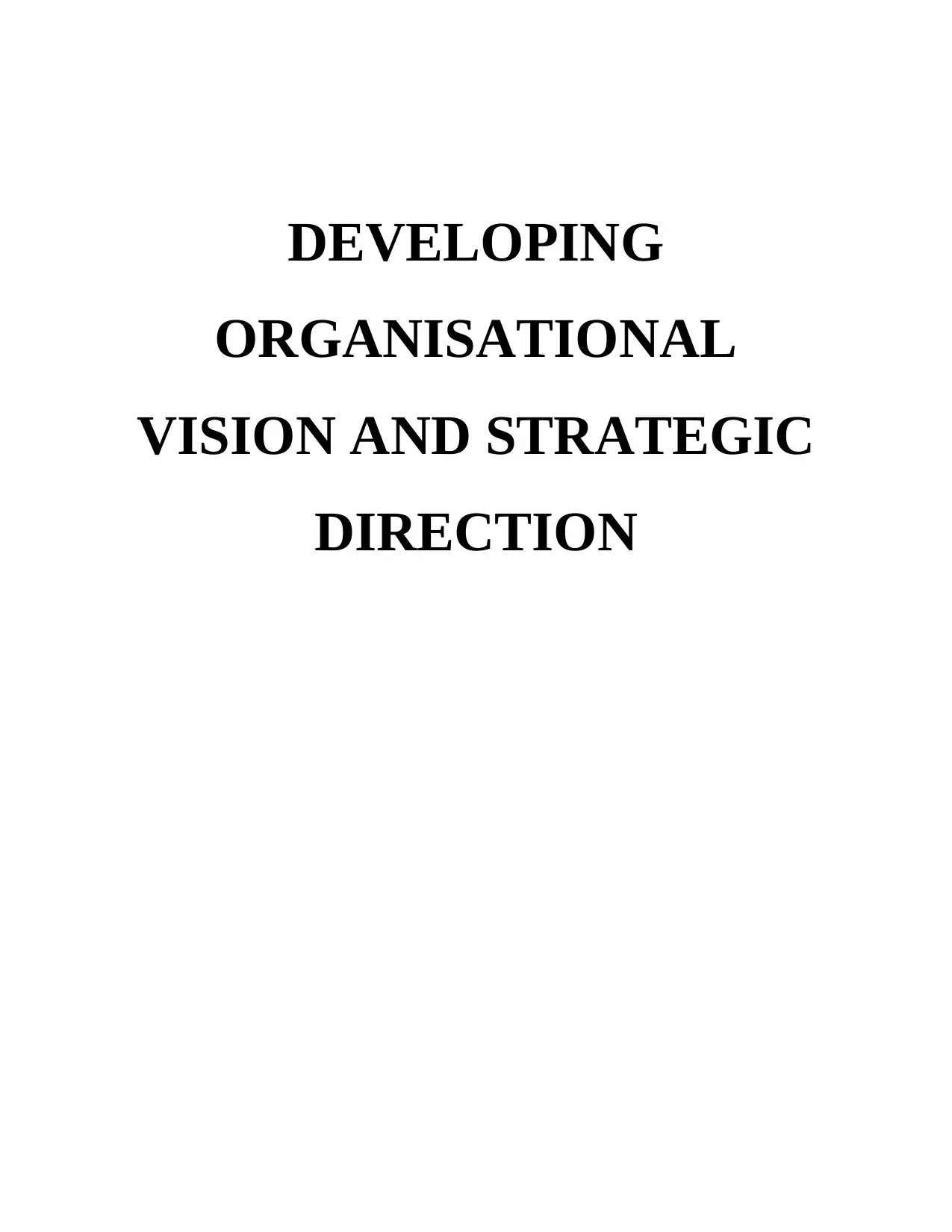
DEVELOPING
ORGANISATIONAL
VISION AND STRATEGIC
DIRECTION
ORGANISATIONAL
VISION AND STRATEGIC
DIRECTION
Paraphrase This Document
Need a fresh take? Get an instant paraphrase of this document with our AI Paraphraser
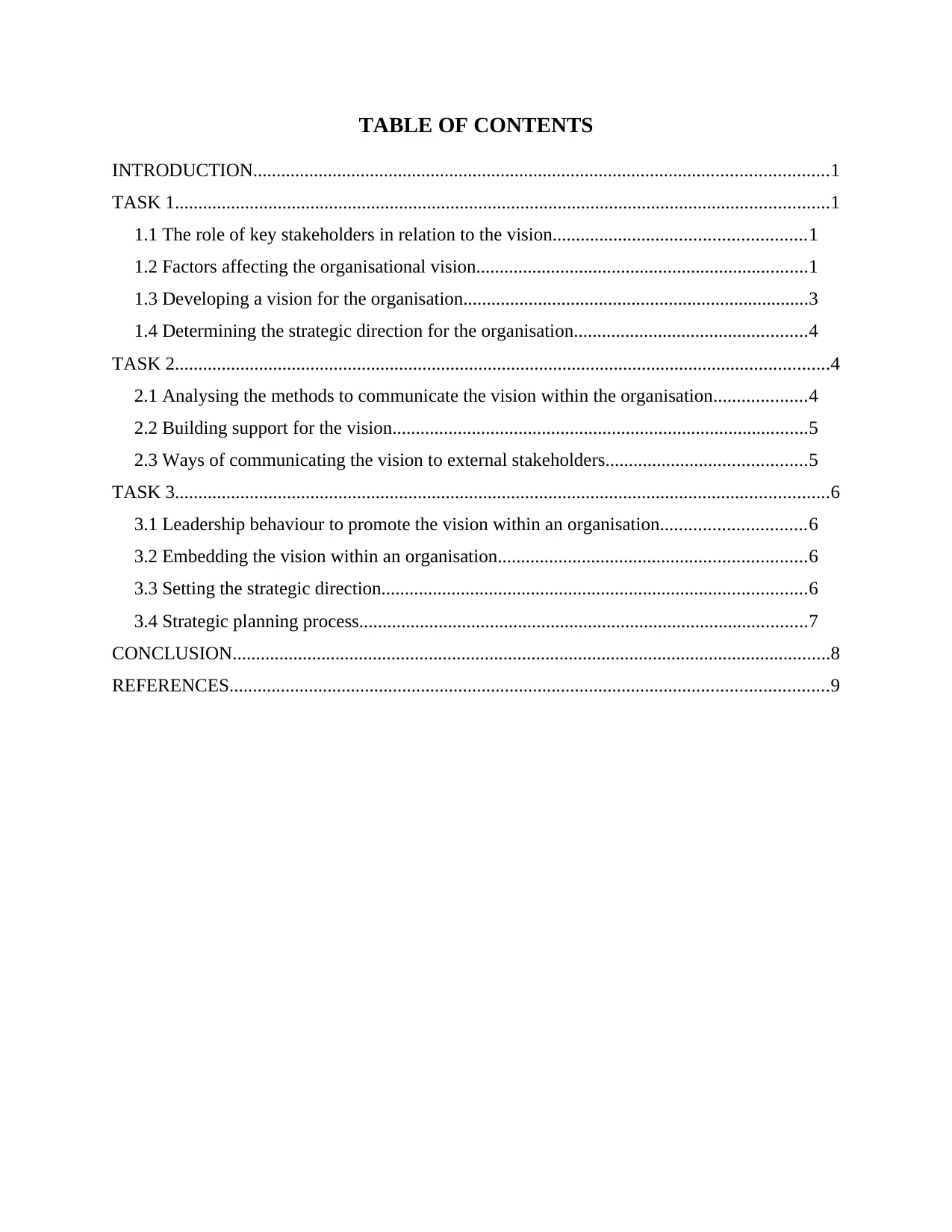
TABLE OF CONTENTS
INTRODUCTION...........................................................................................................................1
TASK 1............................................................................................................................................1
1.1 The role of key stakeholders in relation to the vision......................................................1
1.2 Factors affecting the organisational vision.......................................................................1
1.3 Developing a vision for the organisation..........................................................................3
1.4 Determining the strategic direction for the organisation..................................................4
TASK 2............................................................................................................................................4
2.1 Analysing the methods to communicate the vision within the organisation....................4
2.2 Building support for the vision.........................................................................................5
2.3 Ways of communicating the vision to external stakeholders...........................................5
TASK 3............................................................................................................................................6
3.1 Leadership behaviour to promote the vision within an organisation...............................6
3.2 Embedding the vision within an organisation..................................................................6
3.3 Setting the strategic direction...........................................................................................6
3.4 Strategic planning process................................................................................................7
CONCLUSION................................................................................................................................8
REFERENCES................................................................................................................................9
INTRODUCTION...........................................................................................................................1
TASK 1............................................................................................................................................1
1.1 The role of key stakeholders in relation to the vision......................................................1
1.2 Factors affecting the organisational vision.......................................................................1
1.3 Developing a vision for the organisation..........................................................................3
1.4 Determining the strategic direction for the organisation..................................................4
TASK 2............................................................................................................................................4
2.1 Analysing the methods to communicate the vision within the organisation....................4
2.2 Building support for the vision.........................................................................................5
2.3 Ways of communicating the vision to external stakeholders...........................................5
TASK 3............................................................................................................................................6
3.1 Leadership behaviour to promote the vision within an organisation...............................6
3.2 Embedding the vision within an organisation..................................................................6
3.3 Setting the strategic direction...........................................................................................6
3.4 Strategic planning process................................................................................................7
CONCLUSION................................................................................................................................8
REFERENCES................................................................................................................................9
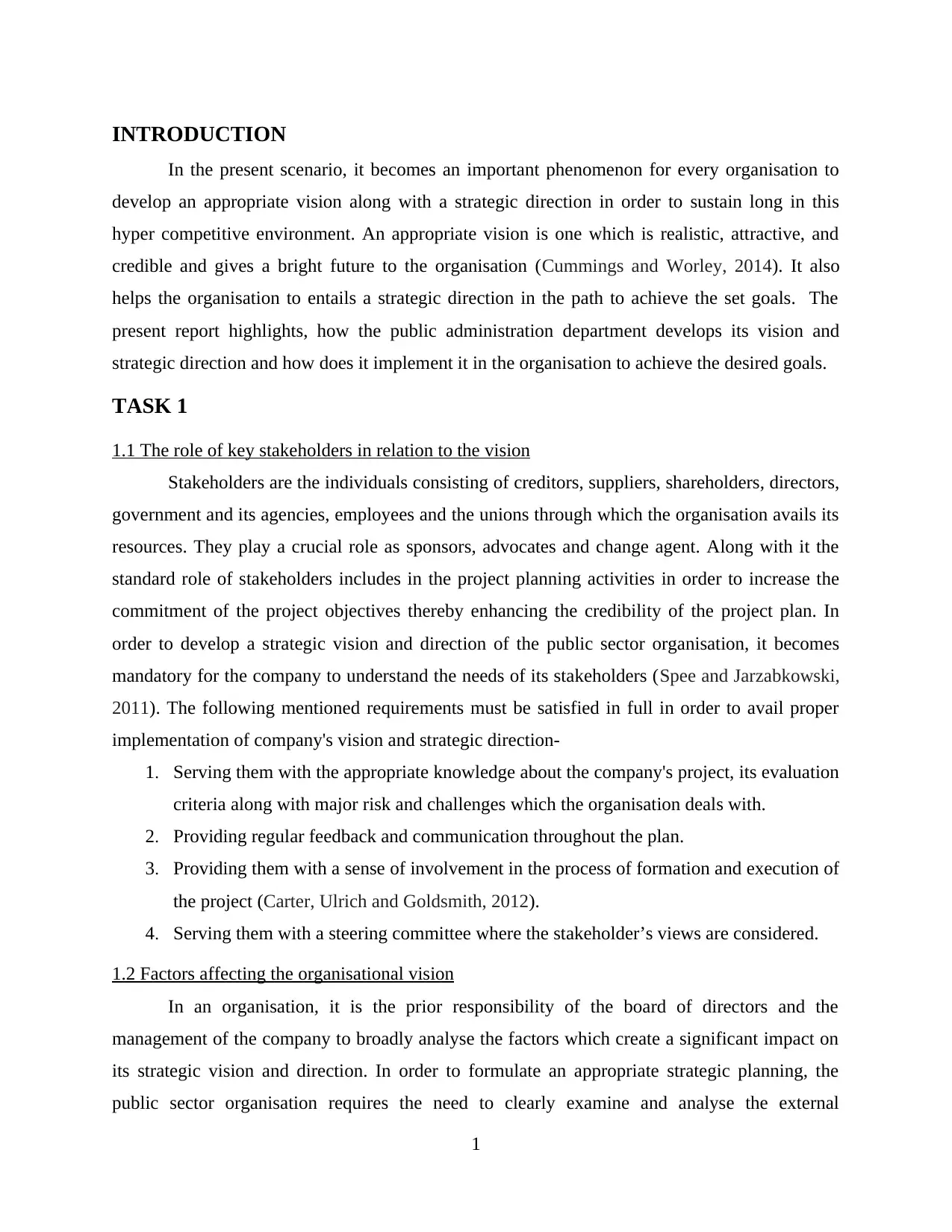
INTRODUCTION
In the present scenario, it becomes an important phenomenon for every organisation to
develop an appropriate vision along with a strategic direction in order to sustain long in this
hyper competitive environment. An appropriate vision is one which is realistic, attractive, and
credible and gives a bright future to the organisation (Cummings and Worley, 2014). It also
helps the organisation to entails a strategic direction in the path to achieve the set goals. The
present report highlights, how the public administration department develops its vision and
strategic direction and how does it implement it in the organisation to achieve the desired goals.
TASK 1
1.1 The role of key stakeholders in relation to the vision
Stakeholders are the individuals consisting of creditors, suppliers, shareholders, directors,
government and its agencies, employees and the unions through which the organisation avails its
resources. They play a crucial role as sponsors, advocates and change agent. Along with it the
standard role of stakeholders includes in the project planning activities in order to increase the
commitment of the project objectives thereby enhancing the credibility of the project plan. In
order to develop a strategic vision and direction of the public sector organisation, it becomes
mandatory for the company to understand the needs of its stakeholders (Spee and Jarzabkowski,
2011). The following mentioned requirements must be satisfied in full in order to avail proper
implementation of company's vision and strategic direction-
1. Serving them with the appropriate knowledge about the company's project, its evaluation
criteria along with major risk and challenges which the organisation deals with.
2. Providing regular feedback and communication throughout the plan.
3. Providing them with a sense of involvement in the process of formation and execution of
the project (Carter, Ulrich and Goldsmith, 2012).
4. Serving them with a steering committee where the stakeholder’s views are considered.
1.2 Factors affecting the organisational vision
In an organisation, it is the prior responsibility of the board of directors and the
management of the company to broadly analyse the factors which create a significant impact on
its strategic vision and direction. In order to formulate an appropriate strategic planning, the
public sector organisation requires the need to clearly examine and analyse the external
1
In the present scenario, it becomes an important phenomenon for every organisation to
develop an appropriate vision along with a strategic direction in order to sustain long in this
hyper competitive environment. An appropriate vision is one which is realistic, attractive, and
credible and gives a bright future to the organisation (Cummings and Worley, 2014). It also
helps the organisation to entails a strategic direction in the path to achieve the set goals. The
present report highlights, how the public administration department develops its vision and
strategic direction and how does it implement it in the organisation to achieve the desired goals.
TASK 1
1.1 The role of key stakeholders in relation to the vision
Stakeholders are the individuals consisting of creditors, suppliers, shareholders, directors,
government and its agencies, employees and the unions through which the organisation avails its
resources. They play a crucial role as sponsors, advocates and change agent. Along with it the
standard role of stakeholders includes in the project planning activities in order to increase the
commitment of the project objectives thereby enhancing the credibility of the project plan. In
order to develop a strategic vision and direction of the public sector organisation, it becomes
mandatory for the company to understand the needs of its stakeholders (Spee and Jarzabkowski,
2011). The following mentioned requirements must be satisfied in full in order to avail proper
implementation of company's vision and strategic direction-
1. Serving them with the appropriate knowledge about the company's project, its evaluation
criteria along with major risk and challenges which the organisation deals with.
2. Providing regular feedback and communication throughout the plan.
3. Providing them with a sense of involvement in the process of formation and execution of
the project (Carter, Ulrich and Goldsmith, 2012).
4. Serving them with a steering committee where the stakeholder’s views are considered.
1.2 Factors affecting the organisational vision
In an organisation, it is the prior responsibility of the board of directors and the
management of the company to broadly analyse the factors which create a significant impact on
its strategic vision and direction. In order to formulate an appropriate strategic planning, the
public sector organisation requires the need to clearly examine and analyse the external
1
⊘ This is a preview!⊘
Do you want full access?
Subscribe today to unlock all pages.

Trusted by 1+ million students worldwide
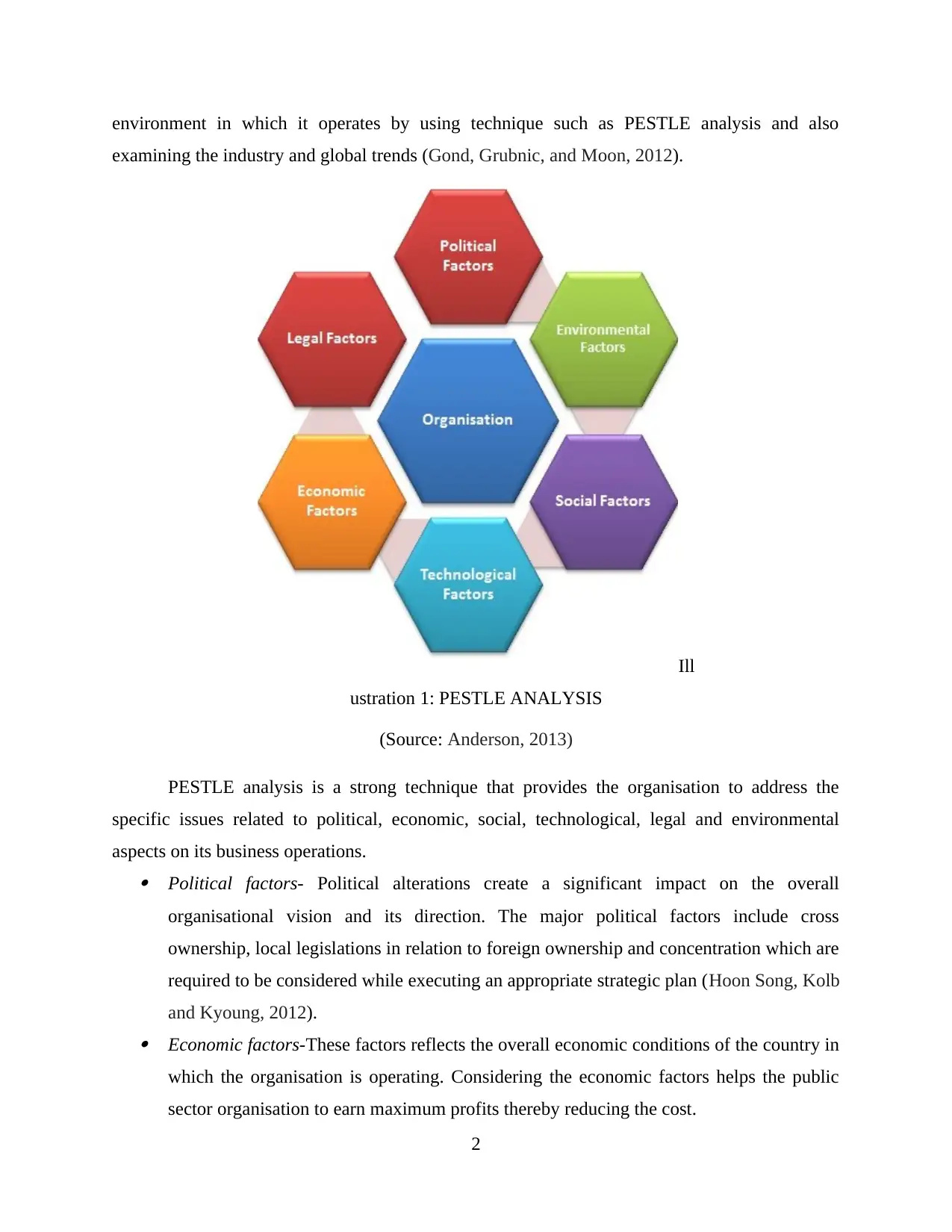
environment in which it operates by using technique such as PESTLE analysis and also
examining the industry and global trends (Gond, Grubnic, and Moon, 2012).
Ill
ustration 1: PESTLE ANALYSIS
(Source: Anderson, 2013)
PESTLE analysis is a strong technique that provides the organisation to address the
specific issues related to political, economic, social, technological, legal and environmental
aspects on its business operations. Political factors- Political alterations create a significant impact on the overall
organisational vision and its direction. The major political factors include cross
ownership, local legislations in relation to foreign ownership and concentration which are
required to be considered while executing an appropriate strategic plan (Hoon Song, Kolb
and Kyoung, 2012). Economic factors-These factors reflects the overall economic conditions of the country in
which the organisation is operating. Considering the economic factors helps the public
sector organisation to earn maximum profits thereby reducing the cost.
2
examining the industry and global trends (Gond, Grubnic, and Moon, 2012).
Ill
ustration 1: PESTLE ANALYSIS
(Source: Anderson, 2013)
PESTLE analysis is a strong technique that provides the organisation to address the
specific issues related to political, economic, social, technological, legal and environmental
aspects on its business operations. Political factors- Political alterations create a significant impact on the overall
organisational vision and its direction. The major political factors include cross
ownership, local legislations in relation to foreign ownership and concentration which are
required to be considered while executing an appropriate strategic plan (Hoon Song, Kolb
and Kyoung, 2012). Economic factors-These factors reflects the overall economic conditions of the country in
which the organisation is operating. Considering the economic factors helps the public
sector organisation to earn maximum profits thereby reducing the cost.
2
Paraphrase This Document
Need a fresh take? Get an instant paraphrase of this document with our AI Paraphraser
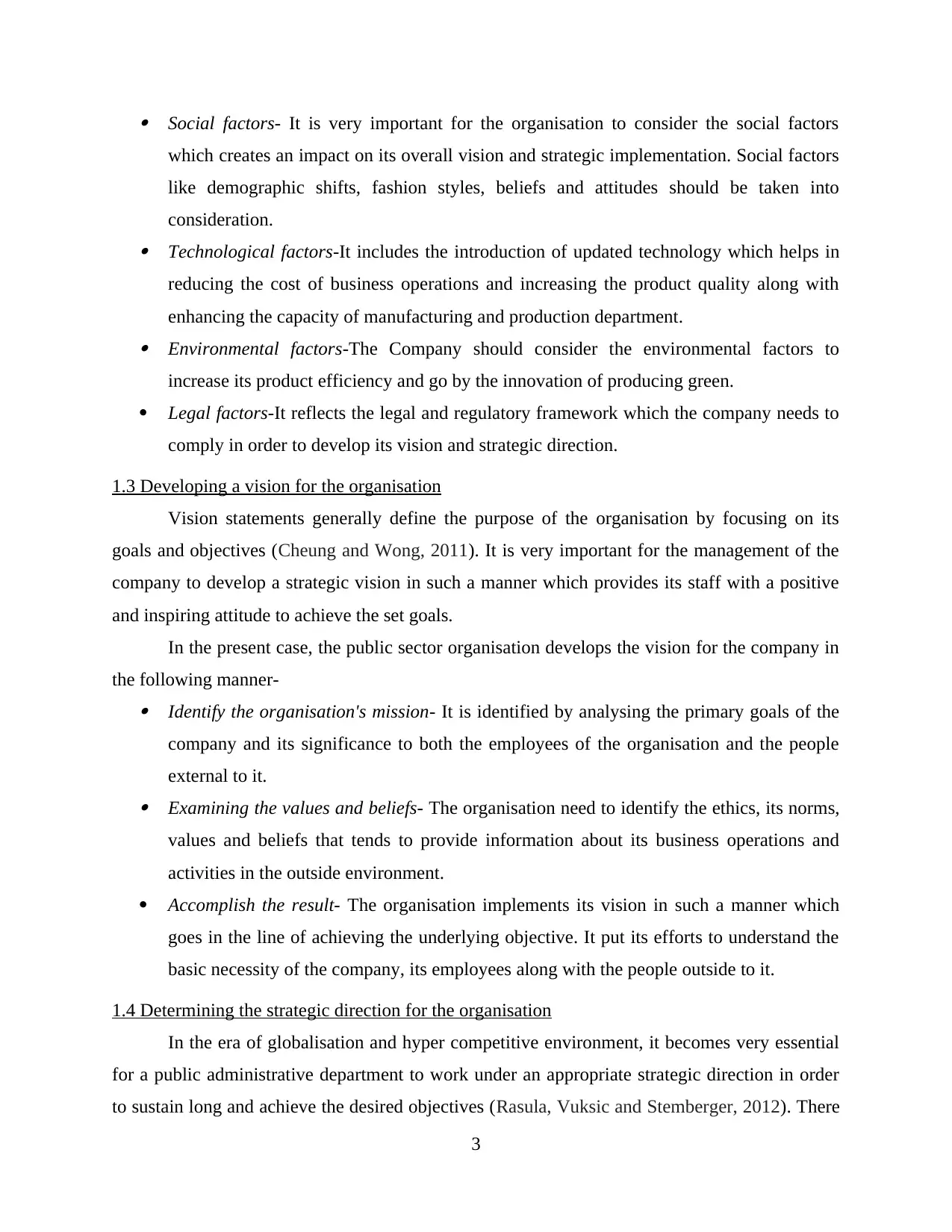
Social factors- It is very important for the organisation to consider the social factors
which creates an impact on its overall vision and strategic implementation. Social factors
like demographic shifts, fashion styles, beliefs and attitudes should be taken into
consideration. Technological factors-It includes the introduction of updated technology which helps in
reducing the cost of business operations and increasing the product quality along with
enhancing the capacity of manufacturing and production department. Environmental factors-The Company should consider the environmental factors to
increase its product efficiency and go by the innovation of producing green.
Legal factors-It reflects the legal and regulatory framework which the company needs to
comply in order to develop its vision and strategic direction.
1.3 Developing a vision for the organisation
Vision statements generally define the purpose of the organisation by focusing on its
goals and objectives (Cheung and Wong, 2011). It is very important for the management of the
company to develop a strategic vision in such a manner which provides its staff with a positive
and inspiring attitude to achieve the set goals.
In the present case, the public sector organisation develops the vision for the company in
the following manner- Identify the organisation's mission- It is identified by analysing the primary goals of the
company and its significance to both the employees of the organisation and the people
external to it. Examining the values and beliefs- The organisation need to identify the ethics, its norms,
values and beliefs that tends to provide information about its business operations and
activities in the outside environment.
Accomplish the result- The organisation implements its vision in such a manner which
goes in the line of achieving the underlying objective. It put its efforts to understand the
basic necessity of the company, its employees along with the people outside to it.
1.4 Determining the strategic direction for the organisation
In the era of globalisation and hyper competitive environment, it becomes very essential
for a public administrative department to work under an appropriate strategic direction in order
to sustain long and achieve the desired objectives (Rasula, Vuksic and Stemberger, 2012). There
3
which creates an impact on its overall vision and strategic implementation. Social factors
like demographic shifts, fashion styles, beliefs and attitudes should be taken into
consideration. Technological factors-It includes the introduction of updated technology which helps in
reducing the cost of business operations and increasing the product quality along with
enhancing the capacity of manufacturing and production department. Environmental factors-The Company should consider the environmental factors to
increase its product efficiency and go by the innovation of producing green.
Legal factors-It reflects the legal and regulatory framework which the company needs to
comply in order to develop its vision and strategic direction.
1.3 Developing a vision for the organisation
Vision statements generally define the purpose of the organisation by focusing on its
goals and objectives (Cheung and Wong, 2011). It is very important for the management of the
company to develop a strategic vision in such a manner which provides its staff with a positive
and inspiring attitude to achieve the set goals.
In the present case, the public sector organisation develops the vision for the company in
the following manner- Identify the organisation's mission- It is identified by analysing the primary goals of the
company and its significance to both the employees of the organisation and the people
external to it. Examining the values and beliefs- The organisation need to identify the ethics, its norms,
values and beliefs that tends to provide information about its business operations and
activities in the outside environment.
Accomplish the result- The organisation implements its vision in such a manner which
goes in the line of achieving the underlying objective. It put its efforts to understand the
basic necessity of the company, its employees along with the people outside to it.
1.4 Determining the strategic direction for the organisation
In the era of globalisation and hyper competitive environment, it becomes very essential
for a public administrative department to work under an appropriate strategic direction in order
to sustain long and achieve the desired objectives (Rasula, Vuksic and Stemberger, 2012). There
3
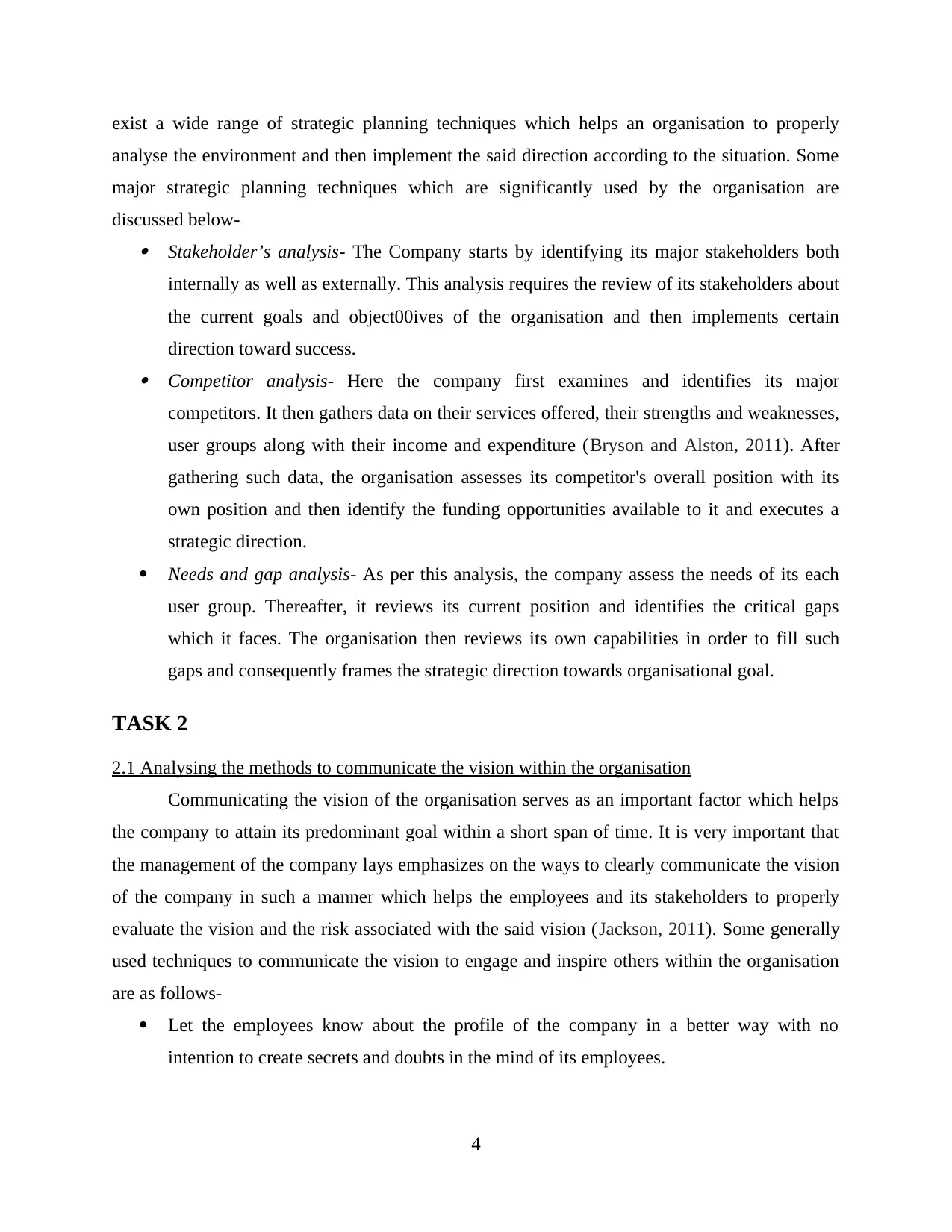
exist a wide range of strategic planning techniques which helps an organisation to properly
analyse the environment and then implement the said direction according to the situation. Some
major strategic planning techniques which are significantly used by the organisation are
discussed below- Stakeholder’s analysis- The Company starts by identifying its major stakeholders both
internally as well as externally. This analysis requires the review of its stakeholders about
the current goals and object00ives of the organisation and then implements certain
direction toward success. Competitor analysis- Here the company first examines and identifies its major
competitors. It then gathers data on their services offered, their strengths and weaknesses,
user groups along with their income and expenditure (Bryson and Alston, 2011). After
gathering such data, the organisation assesses its competitor's overall position with its
own position and then identify the funding opportunities available to it and executes a
strategic direction.
Needs and gap analysis- As per this analysis, the company assess the needs of its each
user group. Thereafter, it reviews its current position and identifies the critical gaps
which it faces. The organisation then reviews its own capabilities in order to fill such
gaps and consequently frames the strategic direction towards organisational goal.
TASK 2
2.1 Analysing the methods to communicate the vision within the organisation
Communicating the vision of the organisation serves as an important factor which helps
the company to attain its predominant goal within a short span of time. It is very important that
the management of the company lays emphasizes on the ways to clearly communicate the vision
of the company in such a manner which helps the employees and its stakeholders to properly
evaluate the vision and the risk associated with the said vision (Jackson, 2011). Some generally
used techniques to communicate the vision to engage and inspire others within the organisation
are as follows-
Let the employees know about the profile of the company in a better way with no
intention to create secrets and doubts in the mind of its employees.
4
analyse the environment and then implement the said direction according to the situation. Some
major strategic planning techniques which are significantly used by the organisation are
discussed below- Stakeholder’s analysis- The Company starts by identifying its major stakeholders both
internally as well as externally. This analysis requires the review of its stakeholders about
the current goals and object00ives of the organisation and then implements certain
direction toward success. Competitor analysis- Here the company first examines and identifies its major
competitors. It then gathers data on their services offered, their strengths and weaknesses,
user groups along with their income and expenditure (Bryson and Alston, 2011). After
gathering such data, the organisation assesses its competitor's overall position with its
own position and then identify the funding opportunities available to it and executes a
strategic direction.
Needs and gap analysis- As per this analysis, the company assess the needs of its each
user group. Thereafter, it reviews its current position and identifies the critical gaps
which it faces. The organisation then reviews its own capabilities in order to fill such
gaps and consequently frames the strategic direction towards organisational goal.
TASK 2
2.1 Analysing the methods to communicate the vision within the organisation
Communicating the vision of the organisation serves as an important factor which helps
the company to attain its predominant goal within a short span of time. It is very important that
the management of the company lays emphasizes on the ways to clearly communicate the vision
of the company in such a manner which helps the employees and its stakeholders to properly
evaluate the vision and the risk associated with the said vision (Jackson, 2011). Some generally
used techniques to communicate the vision to engage and inspire others within the organisation
are as follows-
Let the employees know about the profile of the company in a better way with no
intention to create secrets and doubts in the mind of its employees.
4
⊘ This is a preview!⊘
Do you want full access?
Subscribe today to unlock all pages.

Trusted by 1+ million students worldwide
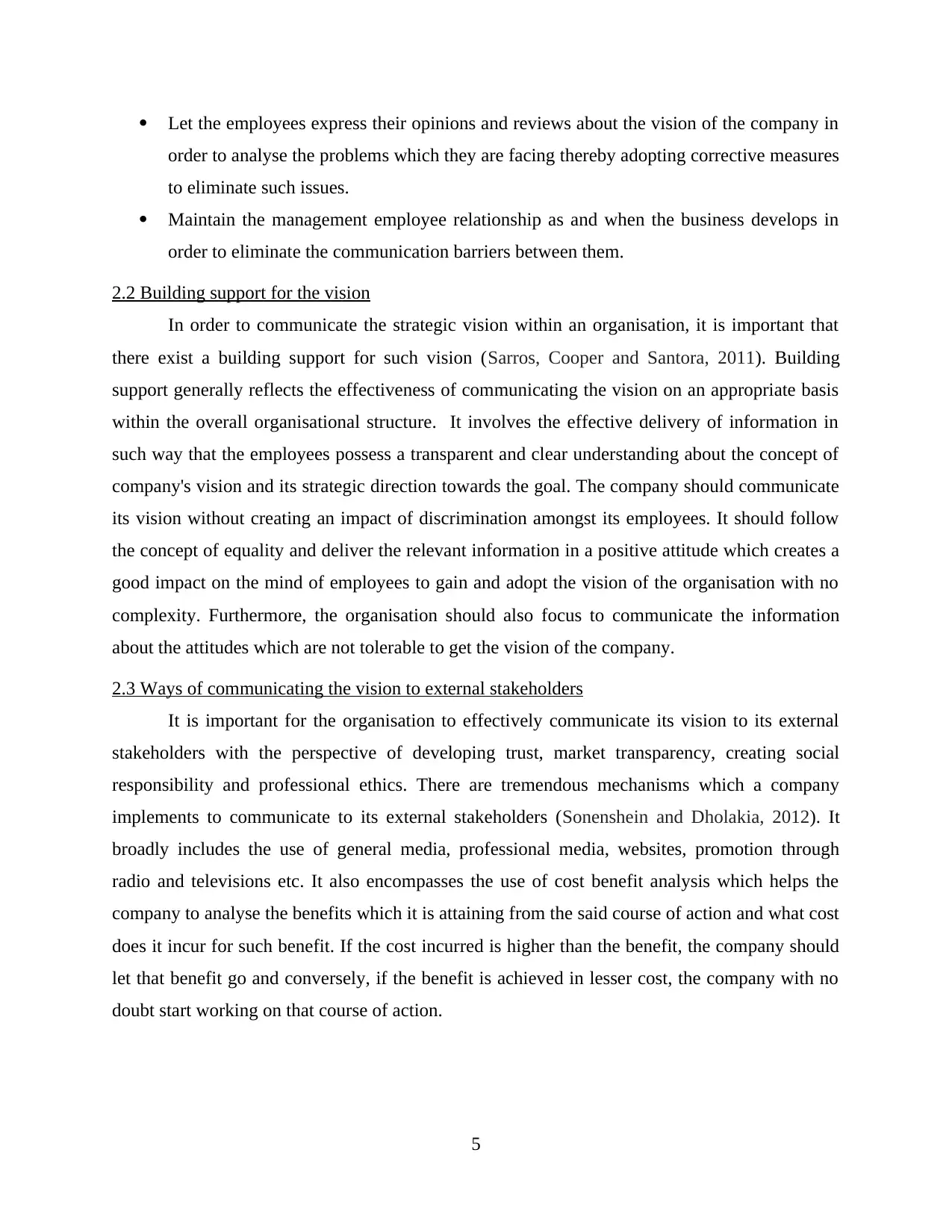
Let the employees express their opinions and reviews about the vision of the company in
order to analyse the problems which they are facing thereby adopting corrective measures
to eliminate such issues.
Maintain the management employee relationship as and when the business develops in
order to eliminate the communication barriers between them.
2.2 Building support for the vision
In order to communicate the strategic vision within an organisation, it is important that
there exist a building support for such vision (Sarros, Cooper and Santora, 2011). Building
support generally reflects the effectiveness of communicating the vision on an appropriate basis
within the overall organisational structure. It involves the effective delivery of information in
such way that the employees possess a transparent and clear understanding about the concept of
company's vision and its strategic direction towards the goal. The company should communicate
its vision without creating an impact of discrimination amongst its employees. It should follow
the concept of equality and deliver the relevant information in a positive attitude which creates a
good impact on the mind of employees to gain and adopt the vision of the organisation with no
complexity. Furthermore, the organisation should also focus to communicate the information
about the attitudes which are not tolerable to get the vision of the company.
2.3 Ways of communicating the vision to external stakeholders
It is important for the organisation to effectively communicate its vision to its external
stakeholders with the perspective of developing trust, market transparency, creating social
responsibility and professional ethics. There are tremendous mechanisms which a company
implements to communicate to its external stakeholders (Sonenshein and Dholakia, 2012). It
broadly includes the use of general media, professional media, websites, promotion through
radio and televisions etc. It also encompasses the use of cost benefit analysis which helps the
company to analyse the benefits which it is attaining from the said course of action and what cost
does it incur for such benefit. If the cost incurred is higher than the benefit, the company should
let that benefit go and conversely, if the benefit is achieved in lesser cost, the company with no
doubt start working on that course of action.
5
order to analyse the problems which they are facing thereby adopting corrective measures
to eliminate such issues.
Maintain the management employee relationship as and when the business develops in
order to eliminate the communication barriers between them.
2.2 Building support for the vision
In order to communicate the strategic vision within an organisation, it is important that
there exist a building support for such vision (Sarros, Cooper and Santora, 2011). Building
support generally reflects the effectiveness of communicating the vision on an appropriate basis
within the overall organisational structure. It involves the effective delivery of information in
such way that the employees possess a transparent and clear understanding about the concept of
company's vision and its strategic direction towards the goal. The company should communicate
its vision without creating an impact of discrimination amongst its employees. It should follow
the concept of equality and deliver the relevant information in a positive attitude which creates a
good impact on the mind of employees to gain and adopt the vision of the organisation with no
complexity. Furthermore, the organisation should also focus to communicate the information
about the attitudes which are not tolerable to get the vision of the company.
2.3 Ways of communicating the vision to external stakeholders
It is important for the organisation to effectively communicate its vision to its external
stakeholders with the perspective of developing trust, market transparency, creating social
responsibility and professional ethics. There are tremendous mechanisms which a company
implements to communicate to its external stakeholders (Sonenshein and Dholakia, 2012). It
broadly includes the use of general media, professional media, websites, promotion through
radio and televisions etc. It also encompasses the use of cost benefit analysis which helps the
company to analyse the benefits which it is attaining from the said course of action and what cost
does it incur for such benefit. If the cost incurred is higher than the benefit, the company should
let that benefit go and conversely, if the benefit is achieved in lesser cost, the company with no
doubt start working on that course of action.
5
Paraphrase This Document
Need a fresh take? Get an instant paraphrase of this document with our AI Paraphraser
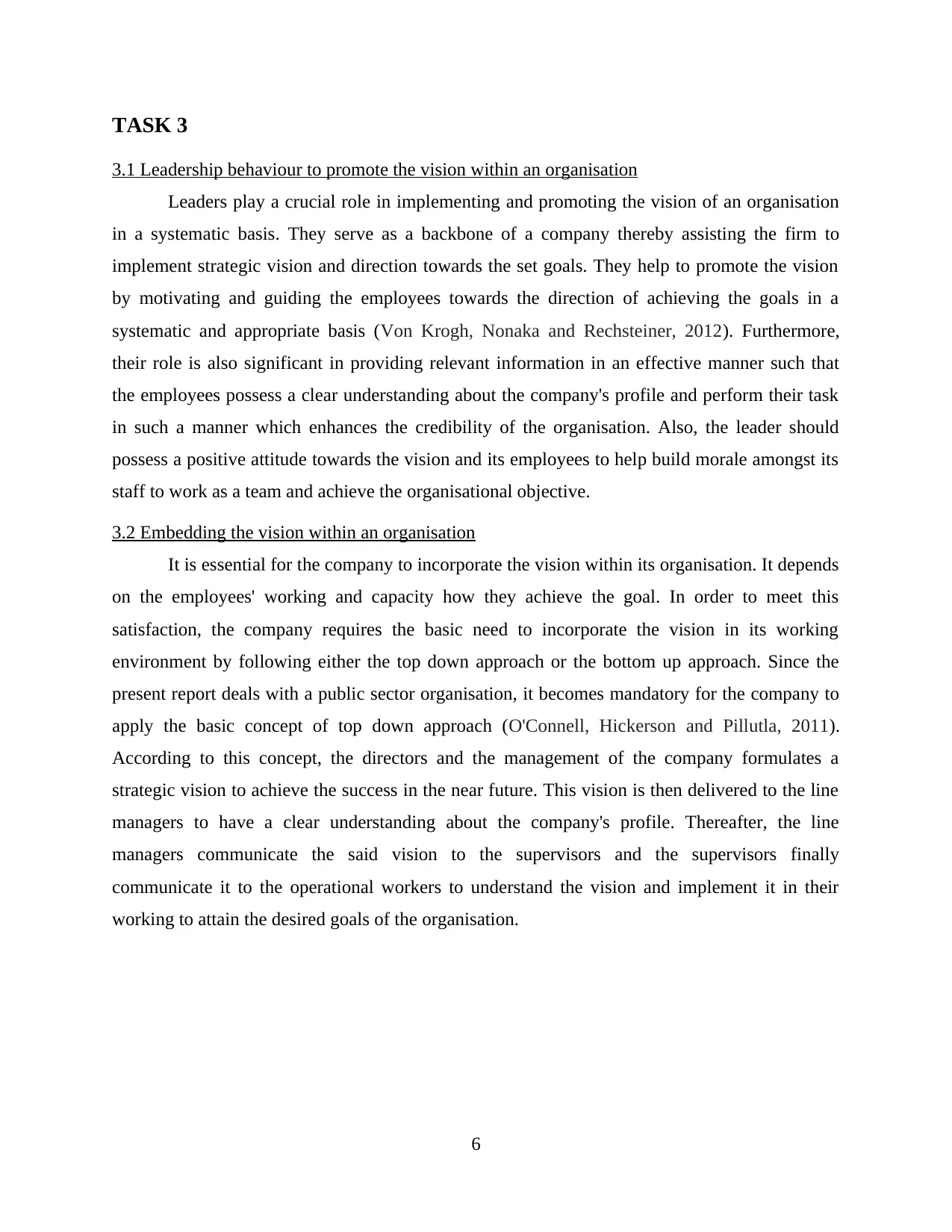
TASK 3
3.1 Leadership behaviour to promote the vision within an organisation
Leaders play a crucial role in implementing and promoting the vision of an organisation
in a systematic basis. They serve as a backbone of a company thereby assisting the firm to
implement strategic vision and direction towards the set goals. They help to promote the vision
by motivating and guiding the employees towards the direction of achieving the goals in a
systematic and appropriate basis (Von Krogh, Nonaka and Rechsteiner, 2012). Furthermore,
their role is also significant in providing relevant information in an effective manner such that
the employees possess a clear understanding about the company's profile and perform their task
in such a manner which enhances the credibility of the organisation. Also, the leader should
possess a positive attitude towards the vision and its employees to help build morale amongst its
staff to work as a team and achieve the organisational objective.
3.2 Embedding the vision within an organisation
It is essential for the company to incorporate the vision within its organisation. It depends
on the employees' working and capacity how they achieve the goal. In order to meet this
satisfaction, the company requires the basic need to incorporate the vision in its working
environment by following either the top down approach or the bottom up approach. Since the
present report deals with a public sector organisation, it becomes mandatory for the company to
apply the basic concept of top down approach (O'Connell, Hickerson and Pillutla, 2011).
According to this concept, the directors and the management of the company formulates a
strategic vision to achieve the success in the near future. This vision is then delivered to the line
managers to have a clear understanding about the company's profile. Thereafter, the line
managers communicate the said vision to the supervisors and the supervisors finally
communicate it to the operational workers to understand the vision and implement it in their
working to attain the desired goals of the organisation.
6
3.1 Leadership behaviour to promote the vision within an organisation
Leaders play a crucial role in implementing and promoting the vision of an organisation
in a systematic basis. They serve as a backbone of a company thereby assisting the firm to
implement strategic vision and direction towards the set goals. They help to promote the vision
by motivating and guiding the employees towards the direction of achieving the goals in a
systematic and appropriate basis (Von Krogh, Nonaka and Rechsteiner, 2012). Furthermore,
their role is also significant in providing relevant information in an effective manner such that
the employees possess a clear understanding about the company's profile and perform their task
in such a manner which enhances the credibility of the organisation. Also, the leader should
possess a positive attitude towards the vision and its employees to help build morale amongst its
staff to work as a team and achieve the organisational objective.
3.2 Embedding the vision within an organisation
It is essential for the company to incorporate the vision within its organisation. It depends
on the employees' working and capacity how they achieve the goal. In order to meet this
satisfaction, the company requires the basic need to incorporate the vision in its working
environment by following either the top down approach or the bottom up approach. Since the
present report deals with a public sector organisation, it becomes mandatory for the company to
apply the basic concept of top down approach (O'Connell, Hickerson and Pillutla, 2011).
According to this concept, the directors and the management of the company formulates a
strategic vision to achieve the success in the near future. This vision is then delivered to the line
managers to have a clear understanding about the company's profile. Thereafter, the line
managers communicate the said vision to the supervisors and the supervisors finally
communicate it to the operational workers to understand the vision and implement it in their
working to attain the desired goals of the organisation.
6
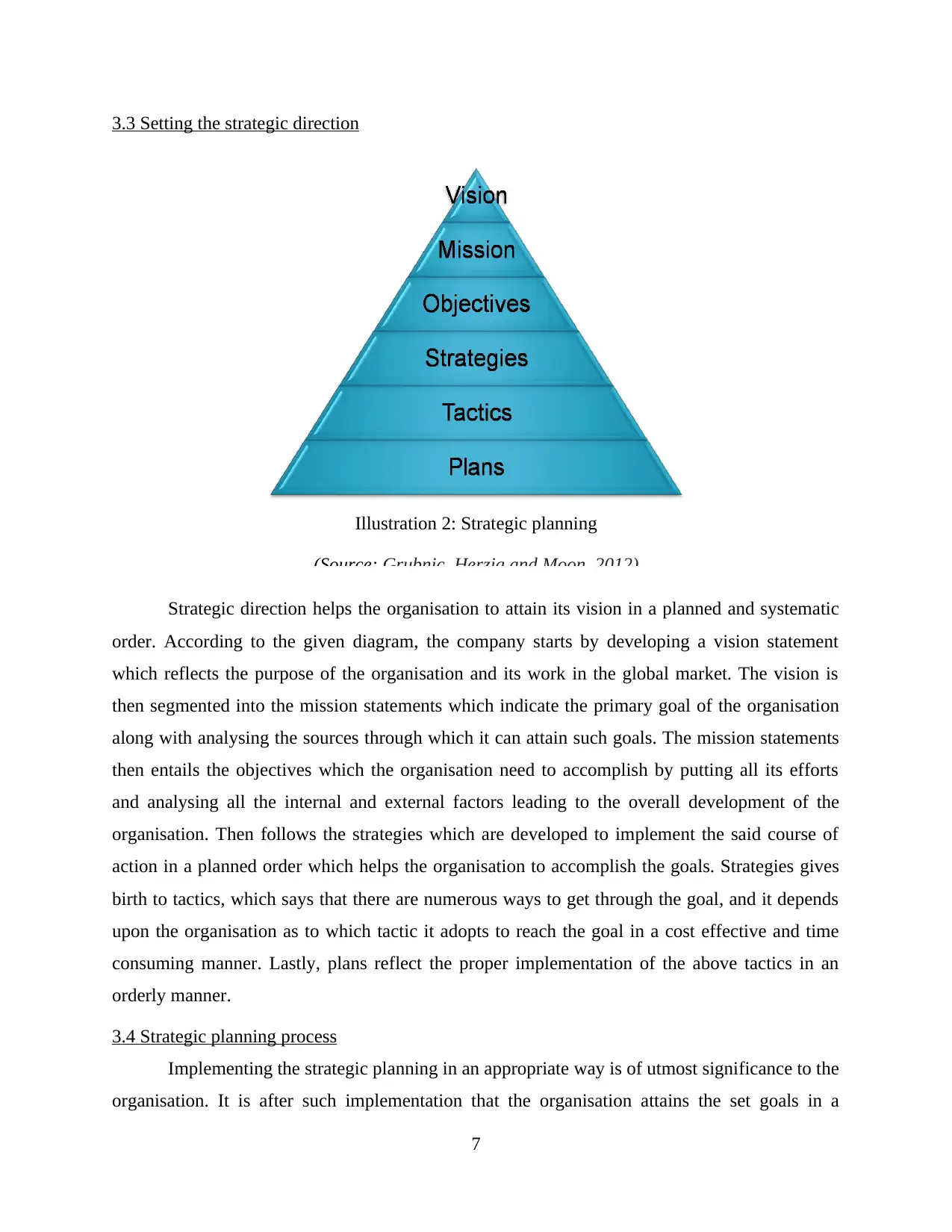
3.3 Setting the strategic direction
Strategic direction helps the organisation to attain its vision in a planned and systematic
order. According to the given diagram, the company starts by developing a vision statement
which reflects the purpose of the organisation and its work in the global market. The vision is
then segmented into the mission statements which indicate the primary goal of the organisation
along with analysing the sources through which it can attain such goals. The mission statements
then entails the objectives which the organisation need to accomplish by putting all its efforts
and analysing all the internal and external factors leading to the overall development of the
organisation. Then follows the strategies which are developed to implement the said course of
action in a planned order which helps the organisation to accomplish the goals. Strategies gives
birth to tactics, which says that there are numerous ways to get through the goal, and it depends
upon the organisation as to which tactic it adopts to reach the goal in a cost effective and time
consuming manner. Lastly, plans reflect the proper implementation of the above tactics in an
orderly manner.
3.4 Strategic planning process
Implementing the strategic planning in an appropriate way is of utmost significance to the
organisation. It is after such implementation that the organisation attains the set goals in a
7
Illustration 2: Strategic planning
(Source: Grubnic, Herzig and Moon, 2012)
Strategic direction helps the organisation to attain its vision in a planned and systematic
order. According to the given diagram, the company starts by developing a vision statement
which reflects the purpose of the organisation and its work in the global market. The vision is
then segmented into the mission statements which indicate the primary goal of the organisation
along with analysing the sources through which it can attain such goals. The mission statements
then entails the objectives which the organisation need to accomplish by putting all its efforts
and analysing all the internal and external factors leading to the overall development of the
organisation. Then follows the strategies which are developed to implement the said course of
action in a planned order which helps the organisation to accomplish the goals. Strategies gives
birth to tactics, which says that there are numerous ways to get through the goal, and it depends
upon the organisation as to which tactic it adopts to reach the goal in a cost effective and time
consuming manner. Lastly, plans reflect the proper implementation of the above tactics in an
orderly manner.
3.4 Strategic planning process
Implementing the strategic planning in an appropriate way is of utmost significance to the
organisation. It is after such implementation that the organisation attains the set goals in a
7
Illustration 2: Strategic planning
(Source: Grubnic, Herzig and Moon, 2012)
⊘ This is a preview!⊘
Do you want full access?
Subscribe today to unlock all pages.

Trusted by 1+ million students worldwide
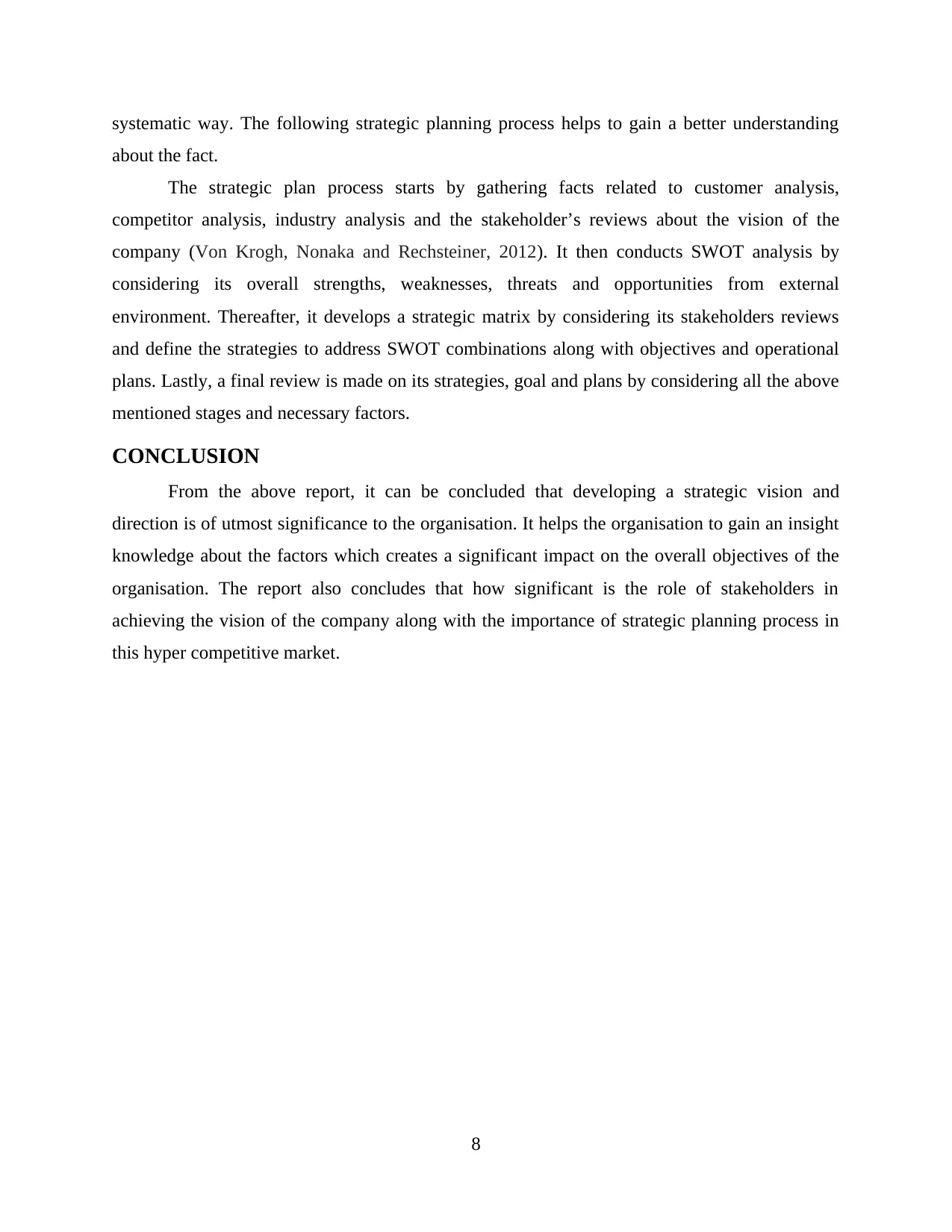
systematic way. The following strategic planning process helps to gain a better understanding
about the fact.
The strategic plan process starts by gathering facts related to customer analysis,
competitor analysis, industry analysis and the stakeholder’s reviews about the vision of the
company (Von Krogh, Nonaka and Rechsteiner, 2012). It then conducts SWOT analysis by
considering its overall strengths, weaknesses, threats and opportunities from external
environment. Thereafter, it develops a strategic matrix by considering its stakeholders reviews
and define the strategies to address SWOT combinations along with objectives and operational
plans. Lastly, a final review is made on its strategies, goal and plans by considering all the above
mentioned stages and necessary factors.
CONCLUSION
From the above report, it can be concluded that developing a strategic vision and
direction is of utmost significance to the organisation. It helps the organisation to gain an insight
knowledge about the factors which creates a significant impact on the overall objectives of the
organisation. The report also concludes that how significant is the role of stakeholders in
achieving the vision of the company along with the importance of strategic planning process in
this hyper competitive market.
8
about the fact.
The strategic plan process starts by gathering facts related to customer analysis,
competitor analysis, industry analysis and the stakeholder’s reviews about the vision of the
company (Von Krogh, Nonaka and Rechsteiner, 2012). It then conducts SWOT analysis by
considering its overall strengths, weaknesses, threats and opportunities from external
environment. Thereafter, it develops a strategic matrix by considering its stakeholders reviews
and define the strategies to address SWOT combinations along with objectives and operational
plans. Lastly, a final review is made on its strategies, goal and plans by considering all the above
mentioned stages and necessary factors.
CONCLUSION
From the above report, it can be concluded that developing a strategic vision and
direction is of utmost significance to the organisation. It helps the organisation to gain an insight
knowledge about the factors which creates a significant impact on the overall objectives of the
organisation. The report also concludes that how significant is the role of stakeholders in
achieving the vision of the company along with the importance of strategic planning process in
this hyper competitive market.
8
Paraphrase This Document
Need a fresh take? Get an instant paraphrase of this document with our AI Paraphraser
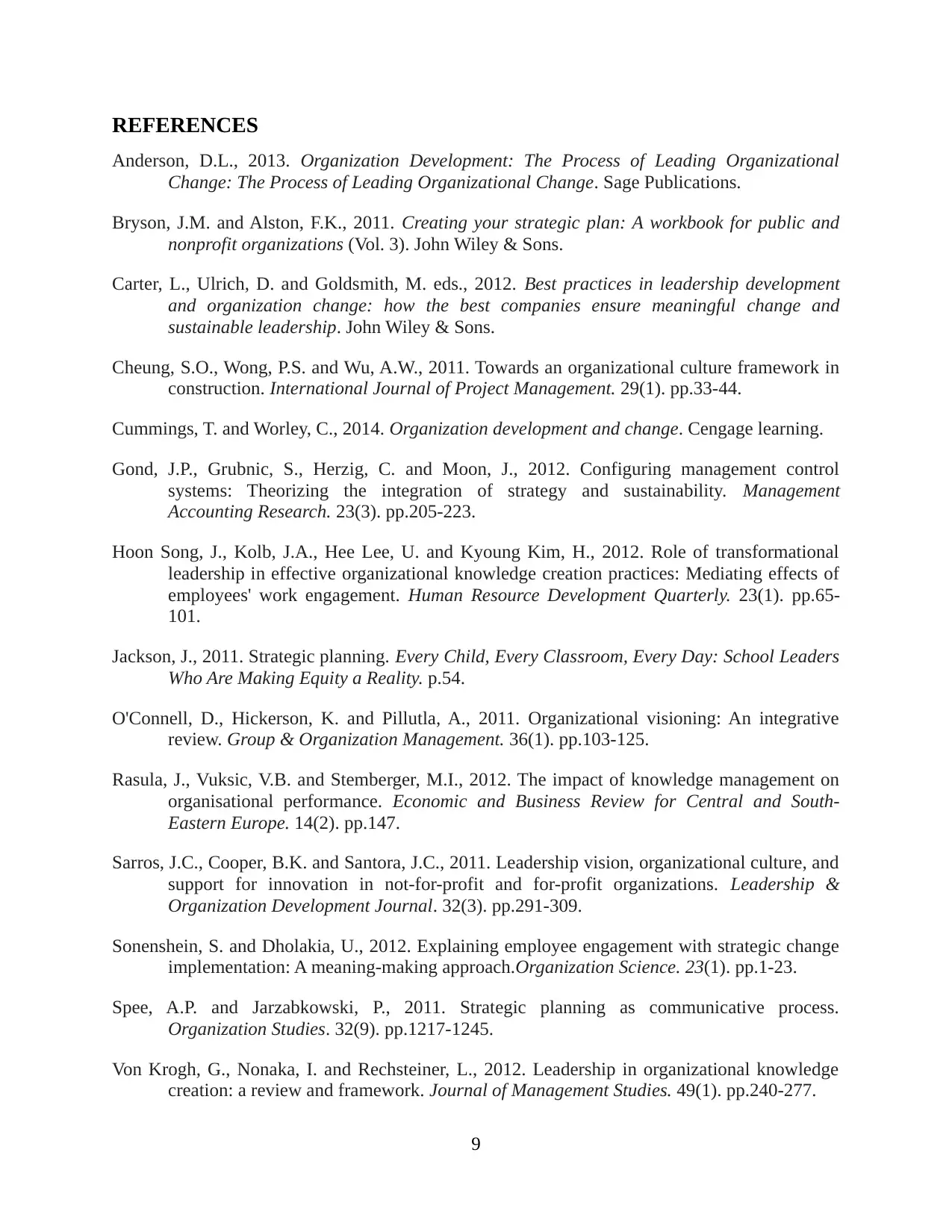
REFERENCES
Anderson, D.L., 2013. Organization Development: The Process of Leading Organizational
Change: The Process of Leading Organizational Change. Sage Publications.
Bryson, J.M. and Alston, F.K., 2011. Creating your strategic plan: A workbook for public and
nonprofit organizations (Vol. 3). John Wiley & Sons.
Carter, L., Ulrich, D. and Goldsmith, M. eds., 2012. Best practices in leadership development
and organization change: how the best companies ensure meaningful change and
sustainable leadership. John Wiley & Sons.
Cheung, S.O., Wong, P.S. and Wu, A.W., 2011. Towards an organizational culture framework in
construction. International Journal of Project Management. 29(1). pp.33-44.
Cummings, T. and Worley, C., 2014. Organization development and change. Cengage learning.
Gond, J.P., Grubnic, S., Herzig, C. and Moon, J., 2012. Configuring management control
systems: Theorizing the integration of strategy and sustainability. Management
Accounting Research. 23(3). pp.205-223.
Hoon Song, J., Kolb, J.A., Hee Lee, U. and Kyoung Kim, H., 2012. Role of transformational
leadership in effective organizational knowledge creation practices: Mediating effects of
employees' work engagement. Human Resource Development Quarterly. 23(1). pp.65-
101.
Jackson, J., 2011. Strategic planning. Every Child, Every Classroom, Every Day: School Leaders
Who Are Making Equity a Reality. p.54.
O'Connell, D., Hickerson, K. and Pillutla, A., 2011. Organizational visioning: An integrative
review. Group & Organization Management. 36(1). pp.103-125.
Rasula, J., Vuksic, V.B. and Stemberger, M.I., 2012. The impact of knowledge management on
organisational performance. Economic and Business Review for Central and South-
Eastern Europe. 14(2). pp.147.
Sarros, J.C., Cooper, B.K. and Santora, J.C., 2011. Leadership vision, organizational culture, and
support for innovation in not-for-profit and for-profit organizations. Leadership &
Organization Development Journal. 32(3). pp.291-309.
Sonenshein, S. and Dholakia, U., 2012. Explaining employee engagement with strategic change
implementation: A meaning-making approach.Organization Science. 23(1). pp.1-23.
Spee, A.P. and Jarzabkowski, P., 2011. Strategic planning as communicative process.
Organization Studies. 32(9). pp.1217-1245.
Von Krogh, G., Nonaka, I. and Rechsteiner, L., 2012. Leadership in organizational knowledge
creation: a review and framework. Journal of Management Studies. 49(1). pp.240-277.
9
Anderson, D.L., 2013. Organization Development: The Process of Leading Organizational
Change: The Process of Leading Organizational Change. Sage Publications.
Bryson, J.M. and Alston, F.K., 2011. Creating your strategic plan: A workbook for public and
nonprofit organizations (Vol. 3). John Wiley & Sons.
Carter, L., Ulrich, D. and Goldsmith, M. eds., 2012. Best practices in leadership development
and organization change: how the best companies ensure meaningful change and
sustainable leadership. John Wiley & Sons.
Cheung, S.O., Wong, P.S. and Wu, A.W., 2011. Towards an organizational culture framework in
construction. International Journal of Project Management. 29(1). pp.33-44.
Cummings, T. and Worley, C., 2014. Organization development and change. Cengage learning.
Gond, J.P., Grubnic, S., Herzig, C. and Moon, J., 2012. Configuring management control
systems: Theorizing the integration of strategy and sustainability. Management
Accounting Research. 23(3). pp.205-223.
Hoon Song, J., Kolb, J.A., Hee Lee, U. and Kyoung Kim, H., 2012. Role of transformational
leadership in effective organizational knowledge creation practices: Mediating effects of
employees' work engagement. Human Resource Development Quarterly. 23(1). pp.65-
101.
Jackson, J., 2011. Strategic planning. Every Child, Every Classroom, Every Day: School Leaders
Who Are Making Equity a Reality. p.54.
O'Connell, D., Hickerson, K. and Pillutla, A., 2011. Organizational visioning: An integrative
review. Group & Organization Management. 36(1). pp.103-125.
Rasula, J., Vuksic, V.B. and Stemberger, M.I., 2012. The impact of knowledge management on
organisational performance. Economic and Business Review for Central and South-
Eastern Europe. 14(2). pp.147.
Sarros, J.C., Cooper, B.K. and Santora, J.C., 2011. Leadership vision, organizational culture, and
support for innovation in not-for-profit and for-profit organizations. Leadership &
Organization Development Journal. 32(3). pp.291-309.
Sonenshein, S. and Dholakia, U., 2012. Explaining employee engagement with strategic change
implementation: A meaning-making approach.Organization Science. 23(1). pp.1-23.
Spee, A.P. and Jarzabkowski, P., 2011. Strategic planning as communicative process.
Organization Studies. 32(9). pp.1217-1245.
Von Krogh, G., Nonaka, I. and Rechsteiner, L., 2012. Leadership in organizational knowledge
creation: a review and framework. Journal of Management Studies. 49(1). pp.240-277.
9

10
⊘ This is a preview!⊘
Do you want full access?
Subscribe today to unlock all pages.

Trusted by 1+ million students worldwide
1 out of 12
Related Documents
Your All-in-One AI-Powered Toolkit for Academic Success.
+13062052269
info@desklib.com
Available 24*7 on WhatsApp / Email
![[object Object]](/_next/static/media/star-bottom.7253800d.svg)
Unlock your academic potential
Copyright © 2020–2025 A2Z Services. All Rights Reserved. Developed and managed by ZUCOL.





